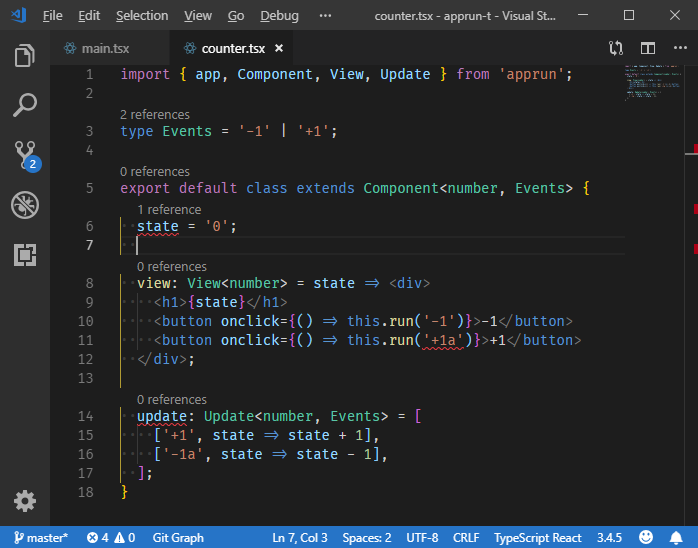Jan 5, 2025
You can now use async generator functions for event handlers. The async generator function can return multiple values. AppRun will render each value in the order they are generated.
const state = {};
const view = state => html`
<div><button @click=${run(getComic)}>fetch ...</button></div>
${state.loading && html`<div>loading ... </div>`}
${state.comic && html`<img src=${state.comic.img} />`}
`;
async function* getComic() { // async generator function returns loading flag and then the comic object
yield { loading: true };
const response = await fetch('https://my-xkcd-api.glitch.me');
const comic = await response.json();
yield { comic };
}
app.start(document.body, state, view);The apprun-html.js now uses lit-html V3 for rendering the view. The apprun-html.js is a standalone version of AppRun that uses lit-html for rendering the view without JSX.
<html lang="en">
<head>
<meta charset="utf-8">
<meta name="viewport" content="width=device-width, initial-scale=1.0">
<title>Counter</title>
</head>
<body>
<script src="https://unpkg.com/dist/apprun-html"></script>
<script>
const add = (state, delta) => state + delta;
const view = state => {
return html`<div>
<h1>${state}</h1>
<button @click=${run(add, -1)}>-1</button>
<button @click=${run(add, +1)}>+1</button>
</div>`;
};
app.start(document.body, 0, view);
</script>
</body>
</html>Aug 12, 2024, V3.33.4
The app.use_render function allows you to use a custom render function for rendering the view. The app.use_react function allows you to use React for rendering the view.
import ReactDOM from 'react-dom/client'
import { flushSync } from 'react-dom';
import app from 'apprun';
use_react(React, ReactDOM);See https://github.com/yysun/apprun-antd-demo-js for an example.
Dec, 8, 2023
When using a component in JSX, AppRun always invokes the the mounted lifecycle function each time the component is loaded.
class ComponentClass extends Component {
mounted = () => console.log('mounted is called');
}
app.render(document.body, <ComponentClass />);However, the mounted function is not called when you start the component manully in the previous versions.
class ComponentClass extends Component {
mounted = () => console.log('mounted is called'); // not called in previous versions
}
new ComponentClass().start(document.body);Now, the mounted function is called when the component is started.
class ComponentClass extends Component {
mounted = () => console.log('mounted is called'); // called in this version
}
new ComponentClass().start(document.body);This change make the mounted funciton compatible in JSX and in manual start.
September, 27, 2023
AppRun now supports the View Transition API at the event level, component level and app level.
Event level example:
const update = {
'+1': [state => state + 1, {transition: true}],
'-1': [state => state - 1, {transition: true}]
};Component level example:
class C extends Component {
}
new C().mount(document.body, {transition: true});App level example:
app.start(document.body, {transition: true});December 11, 2022
The command npm create apprun-app supports Vite in addition to esbuild and webpack.
You can use React for rendering view. See apprun-use-react for details.
React 18 has breaking changes. Please use React 17 for now.
April 5 , 2022
You can create an AppRun app by running command npm create apprun-app.
npm create apprun-app [my-app]Note: AppRun CLI
npx apprun initis deprecated. Please usenpm create apprun-appinstead.
This post compares the coding style, bundle size, and performance of 55 different ways to make a Web Component. It put AppRun on the top 1/3 of the list of bundle size and performance.
This post introduces apprun-dev-server, a dev server that provides fast and productive experiences to AppRun application development, so-called unbundled development.
This post introduces a new application architecture that allows event handling between the frontend apps and the backend business logic modules without REST API.
Published on Mar 9, 2020 6 min read
This post describes how to create a state machine in AppRun applications to help event handling using a calculator as an example.
Published on Mar 3, 2020 ・ 6 min read
This post describes the advanced usage of the AppRun ref, element embedding, and directive in the JSX view.
Published on Feb 28, 2020 ・ 4 min read
This post is a complete guide for those want to opted-in TypeScript and strong typing for AppRun application development.
Published on May 17, 2019 · 8 min read
This post introduces the two built-in directives and then describes how to create custom directives.
Published on May 12, 2019 · 3 min read
Published on Jan 9, 2019
We have been using the command-line interface (CLI) in the terminal window and the command prompt. Have you thought of a CLI in the console of the browser's developer tool?
Published on Aug 10, 2018 · 1 min read
A single-page application (SPA) is a web application or web site that interacts with the user by dynamically rewriting the current page…
Published on Aug 7, 2018 · 3 min read
I felt it was quite fun to compare AppRun with Redux and React Context API last time. Today, I found another great post titled “I created…
Published on Aug 5, 2018 · 7 min read
Recently, I have read a great post titled ‘Redux vs. The React Context API’ (https://daveceddia.com/context-api-vs-redux). It is the type…
Published on Jul 31, 2018 · 3 min read
Published on Sep 10, 2017 · 8 min read
Published on Sep 9, 2017 · 6 min read
AppRun is a Javascript library for building reliable, high-performance web applications using the Elm inspired Architecture, events and components.
Published on Jul 2, 2017 · 5 min read







